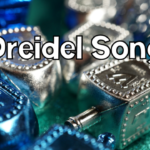The dreidel, a spinning top with Hebrew letters, is an iconic Hanukkah symbol. The dreidel letters include four Hebrew letters – Nun, Gimel, Hay, and Shin. Each of the four letters stands for a Hebrew word, which we’ll get into later in this article.
The origins of the dreidel can be traced back to a time when Jewish people faced religious persecution. Jews weren’t allowed to practice their faith freely. However, they continued to teach their religious texts secretly. To make sure their religious teachings remained a secret, they used the dreidel as a diversionary tool. If authorities approached, the students would quickly pull out the spinning tops, pretending to play a harmless game.
Each side of the dreidel features a specific Hebrew letter: Nun (נ), Gimel (ג), Hey (ה), and Shin (ש). These letters stand for the phrase “Nes Gadol Haya Sham” (נס גדול היה שם), meaning “A Great Miracle Happened There.” This phrase refers to the miraculous event of Hanukkah, where a small jar of oil intended for one day lasted eight days in the rededicated Second Temple, symbolizing God’s presence and divine intervention.
While the standard dreidel used worldwide contains the four letters representing the miracle that occurred in Jerusalem, various Jewish communities have developed unique regional variations. For example, in Israel, dreidels feature the letter “Pey” (פ) instead of “Shin,” signifying “A Great Miracle Happened Here,” as the miracle occurred directly in the land of Israel. These local variations add an extra layer of cultural diversity to the cherished tradition.
The dreidel game is a beloved Hanukkah tradition enjoyed by children and adults alike. It involves spinning the top and following the dreidel game instructions dictated by the letter facing up when it comes to a rest. Depending on the letter, players may add or take coins (usually gelt, chocolate coins), or do nothing. This timeless game fosters a sense of joy, camaraderie, and friendly competition among family and friends during the festive holiday season.
As we gather with loved ones to celebrate Hanukkah, let us remember the profound message carried by the dreidel letters: the enduring power of miracles, the strength of unity, and the triumph of hope over darkness. Whether we’re spinning the top for fun or embracing the lessons it teaches, the dreidel reminds us of the timeless traditions that connect us to our past, celebrate our present, and illuminate our future.
So, this Hanukkah, let the dreidel spin, and may it bring joy, wonder, and a renewed appreciation for the enduring beauty of Jewish culture and tradition.
חַג שָׂמֵחַ Happy Holiday!





